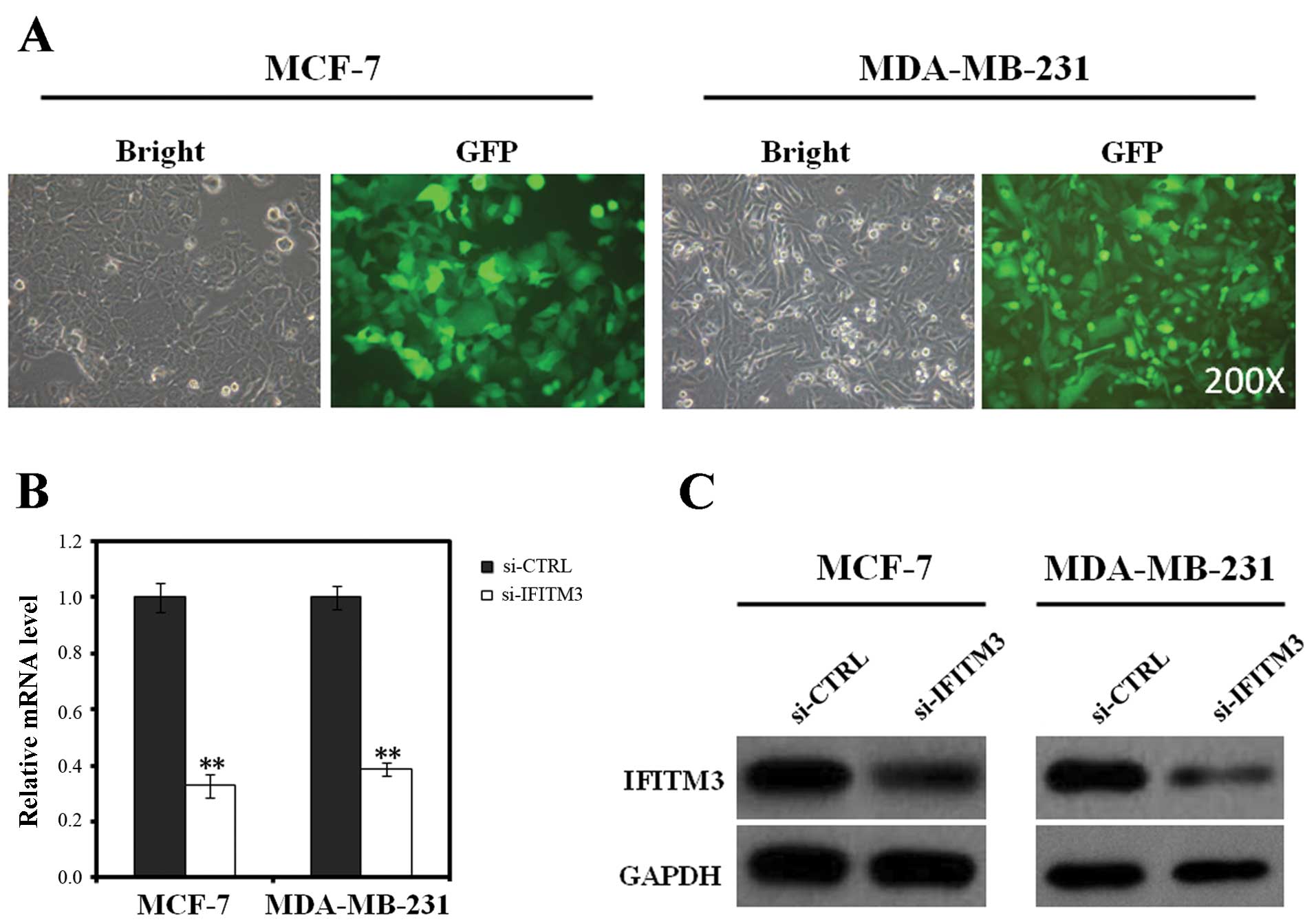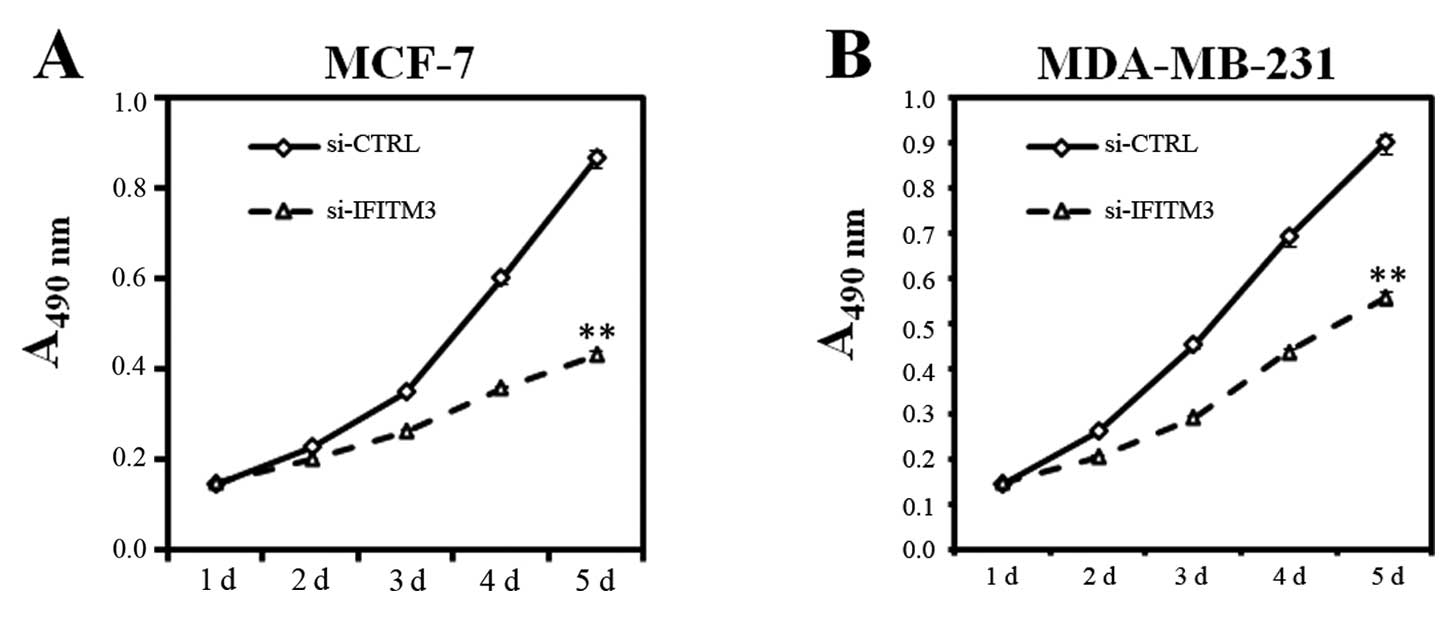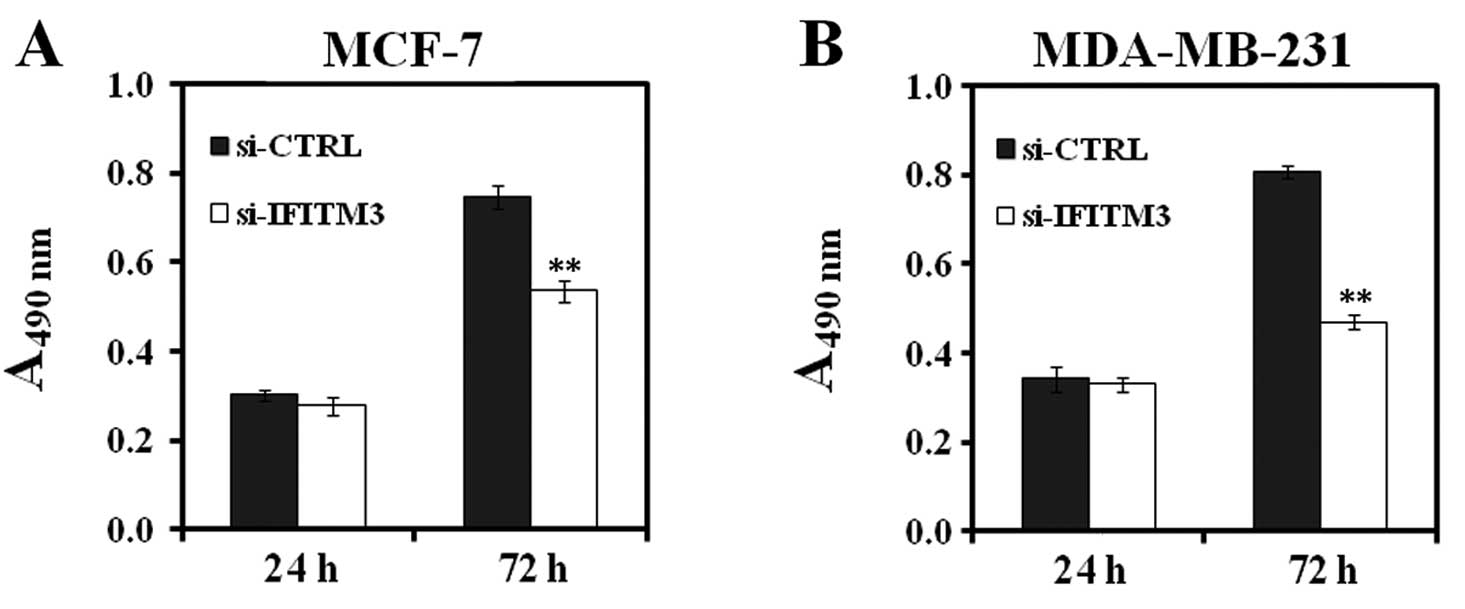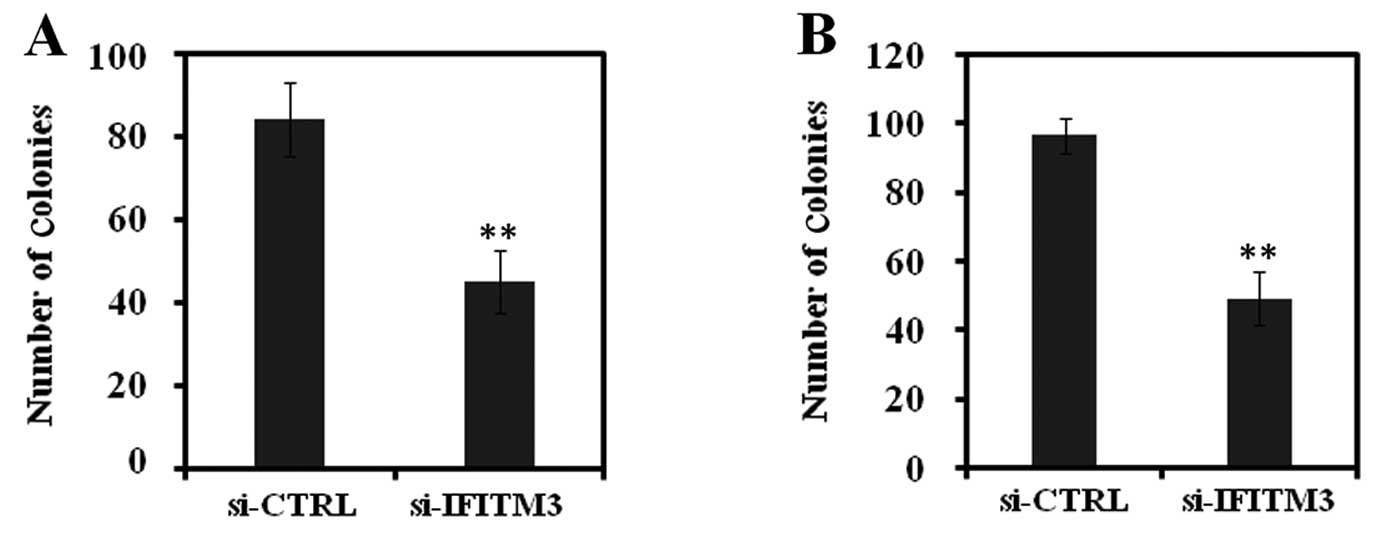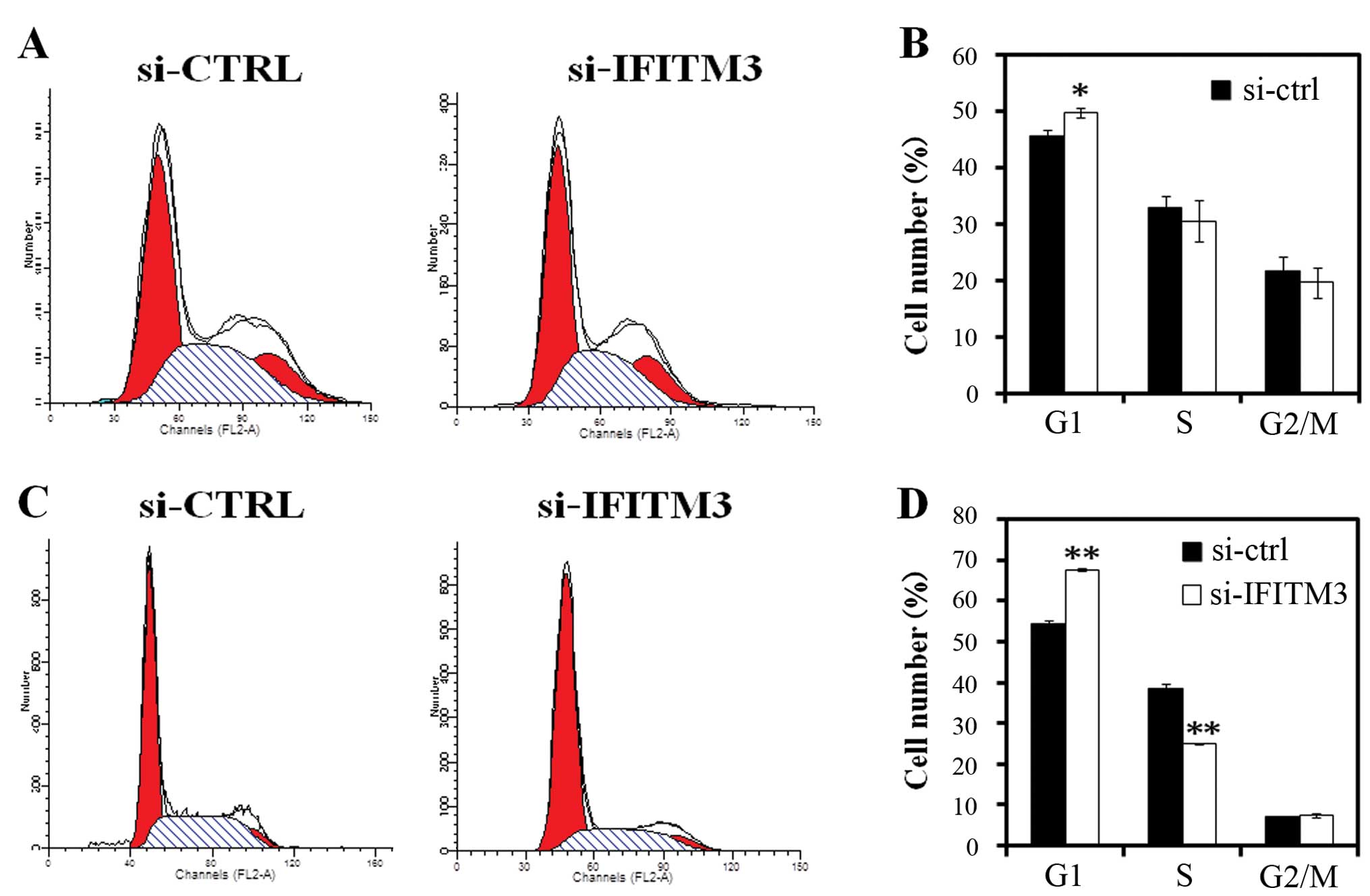Knockdown of interferon-induced transmembrane protein 3 expression suppresses breast cancer cell growth and colony formation and affects the cell cycle
- Authors:
- Published online on: April 26, 2013 https://doi.org/10.3892/or.2013.2428
- Pages: 171-178
Abstract
Introduction
Breast cancer is a significant worldwide health problem and the most commonly diagnosed neoplasm in women (1). Breast cancer accounts for 1.38 million new cancer cases and more than 450,000 cancer deaths annually in the world. Of the breast cancers up to 80% are invasive ductal breast carcinoma (IDC) (2). IDC has similar biological features or pathological types, but this sporadic breast malignancy is triggered by a complex pathogenesis and multiple gene mutations (3). To date, the incidence rate of breast cancer has gradually reduced and the survival rate has increased due to recent advancement in early detection, prevention and targeted therapy. However, the mechanisms responsible for breast cancer initiation, recurrence or metastasis remain to be defined. Thus, new approaches and the discovery of novel target-based molecules are urgently needed to effectively control breast cancer and increase the survival of patients.
Interferon-induced transmembrane proteins (IFITM) are a family of transmembrane proteins that contain two α helical domains. To date, there are five IFITMs (IFITM1, IFITM2, IFITM3, IFITM5 and IFITM10) (4–7) that are all clustered on chromosome 11 with less than 2 kb next to each fragment. The main function of this protein family is to inhibit the invasion of many pathogenic viruses, such as HIV (8). However, more recently, they have been found to play a role in tumorigenesis and cell adhesion and signaling, and are involved in early embryonic development and the regulation of cell growth (9). Furthermore, they may act as tumor markers (10,11). Indeed, in a previous study, Wang et al(12) identified that the expression of IFITM2 protein was significantly increased in HER2-overexpressing mouse mammary tumors, while other investigators proposed that IFITM3 protein may be involved in diverse cellular processes (7,13,14), including immune-cell regulation, somitogenesis, germ cell homing and maturation, cell proliferation (15) and heart development (16). Previous studies demonstrated that IFITM3 expression was significantly upregulated in colorectal cancer (10) and played a critical role in regulating tumor cell migration and invasion, which contribute to the progression of gastric and head and neck cancers (17,18).
However, up to date, only a few studies have reported the role of IFITM3 in breast cancer. Thus, in the present study, we first detected the expression of IFITM3 protein in normal, premalignant and invasive breast tissues, and then investigated the effects of IFITM3 knockdown with lentiviral shRNA on the regulation of breast cancer cell growth and colony formation and cell cycle distribution.
Materials and methods
Breast cancer tissue specimens and clinicopathological features
In the present study, we collected 64 cases of breast cancer tissue specimens from the Second Hospital of Jilin University (Jilin, China) between March 2010 and April 2011. These 64 cases were formalin-fixed and paraffin-embedded specimens and included 15 cases of ductal carcinoma in situ (DCIS) and 49 cases of IDC. Pathology diagnosis of each patient was made by at least two pathologists and the patients underwent mastectomy at the Second Hospital of Jilin University. Next, immunohistochemical analysis of tumor tissues showed that there were 12 triple negative breast cancers among the 49 IDC cases. Tumor staging for these specimens was carried out according to the American Joint Committee on Cancer Staging criteria (19). The use of human specimens was approved by appropriate institutional review boards.
Immunohistochemistry
The tissue samples were fixed in 10% neutral formalin, embedded in paraffin and sectioned at 2 μm. After de-paraffinization and rehydration, the sections were subjected to antigen retrieval with a citrate buffer (pH 6.0) in a pressure cooker. Immunohistochemistry was performed using an IFITM3 polyclonal antibody at a dilution of 1:200 from Proteintech Group, Inc. (cat. #11714-1-AP; Chicago, IL, USA) at 4°C overnight or a monoclonal antibody against estrogen receptor (ER), progesterone receptor (PR) or Her2/neu protein (Dako, Glostrup, Denmark). Negative controls were incubated with PBS instead of the primary antibody.
The immunostained sections were independently evaluated by two pathologists (W.S. and Q.S.S.). Both staining intensity and percentage of staining were reviewed and scored using a semi-quantitative grading system: negative and weak, moderate or strongly positive. These three scores were summarized as negative, low (weak staining) or high (moderate or strong staining) expression of the gene.
Cells lines and cell culture
The human breast cancer MDA-MB-231 and MCF-7 cell lines and the human renal epithelial 293T cell line (ATCC, Manassas, VA, USA) were maintained at 37°C in a humidified atmosphere of 95% air and 5% CO2. MDA-MB-231 cells were cultured in monolayer with Dulbecco’s modified Eagle’s media (DMEM; Gibco, New York, NY, USA) supplemented with 10% fetal bovine serum (FBS; Gibco) and 4 m ML-Glutamine (Sigma, St. Louis, MO, USA). MCF-7 cells was cultured in a monolayer with DMEM containing 4 mM L-Glutamine, 0.1 mM MEM Non-essential amino acids (Sigma) and 10% FBS. The 293T cell line was cultured in DMEM supplemented with 10% FBS, 100 units/ml penicillin and 0.1 mg/ml streptomycin (Sigma).
Lentiviral plasmid construction and infection
An shRNA sequence (5′-CCTGTTCAACACCCTCTTCAT-3′) was used to target IFITM3 (GenBank code: NM_021034) and was purchased by Neuron Biotech Co., Ltd. (Shanghai, China). IFITM3 RNAi was then tested for the knockdown efficiency of IFITM3 in vitro. The small hairpin RNA (shRNA) oligonucleotides were cloned into the pLKD vector (Neuron Biotech Co.). Similarly, the widely used negative control (NC) sequence (5′-TTCTCCGAACGTGTCACGT-3′) was also synthesized and cloned into the pLKD vector as negative control. These vectors were amplified, the DNA sequence was confirmed, and then named as pLKD-shIFITM3 and pLKD-NC, respectively. Next, the lentivirus vector, which contained a green fluorescent protein (GFP) and a U6 terminator inserted between AgeI and EcoRI, and pLKD-shIFITM3 or pLKD-NC were co-transfected into 293T cells. The 293T cells already carried the stably transfected viral envelope and packaging vectors as previously described (20). The lentiviral particles were harvested from the media after 48-h transfection and purified with ultracentrifugation. The virus titer (multiplicity of infection; MOI) was determined using the plaque-forming assay as previously described (21,22).
To knock down IFITM3 expression in breast cancer cell lines, the lentiviruses were used to infect breast cancer cells (si-CTRL group and si-IFITM3 group). In brief, MDA-MB-231 and MCF-7 cells were seeded at 50,000 cells/well in 6-well plates with a small volume of Opti-MEM, grown for 24 h, and then infected with lentiviruses. The cells were then further incubated with normal growth medium 24 h after infection, and after 72 h, the infection was efficiency detected by the GFP in these MDA-MB-231 and MCF-7 cells. Our data showed an ~90% infection rate when a MOI of 15 and 20 was used, and these MOIs did not cause toxicity to the cells. Finally, the cells were harvested for subsequent experiments.
Quantitative reverse transcription polymerase chain reaction (qRT-PCR)
Total RNA was isolated from cultured cells five days after lentiviral infection using a TRIzol reagent (Invitrogen, Carlsbad, CA, USA) according to the manufacturer’s protocol. Two micrograms of the RNA samples were then reversely transcribed into cDNA using the protocol of the M-MLV Reverse transcriptase (Promega, Madison, WI, USA). qPCR was performed with 20 μl of PCR mixtures that contained 0.5 μl primer each, 10 μl 2X SYBR Premix Ex Taq (Takara, Osaka, Japan) and 1 μl cDNA sample in TP800 (Takara). The primer sequences were: IFITM3 (5′-TGTCCAAACCTTCTTCTC-3′ and 5′-CGTCGCCAACCATCTTCC-3′) and β-actin (5′-GGCGGCACCACCATGTACCCT-3′ and 5′-AGGGGCCGGACTCGTCATACT-3′) qPCR amplification conditions were as follows: an initial denaturation at 95°C for 15 sec and then 45 cycles of 95°C for 5 sec and 60°C for 30 sec. The relative expression of IFITM3 mRNA was calculated using the 2−ΔΔCT method (23). All experiments were in duplicate and repeated at least three times.
Protein extraction and western blot analysis
After five days of viral infection, cells were washed with phosphate-buffered saline (PBS; pH 7.4) and lysed with a lysis buffer [10 mM Tris-HCl/pH 8.0, 85 mM KCl, 0.5% NP-40 plus protease inhibitors (1 μM each of chymostatin, leupeptin, antipain and pepstatin-A, and 1 mM each of phenylmethylsulfonyl fluoride and benzamidine)] and then centrifuged at 4°C for 15 min. These cell lysates were then separated on 12% sodium dodecyl sulfate polyacrylamide gels and transferred onto PVDF membranes (Millipore, Bedford, MA, USA). Next, the membranes were incubated with 5% skim milk/PBS for 1 h at room temperature. Membranes were then incubated with a rabbit polyclonal antibody against IFITM3 (1:200, cat. #sc-130785; Santa Cruz Biotechnology, Santa Cruz, CA, USA) or a mouse monoclonal anti-glyceraldehyde 3-phosphate dehydrogenase (GAPDH) antibody (1:1,000, cat. #sc-32233; Santa Cruz Biotechnology) overnight at 4°C. The next day, the membranes were washed with PBS-T and were further incubated with appropriate horseradish peroxidase (HRP) conjugated secondary antibodies at 1:3,000 at room temperature for 2 h. The protein signals were finally detected using an enhanced chemiluminescence system (Amersham Life Sciences, Arlington Heights, IL, USA) according to the protocol provided by the manufacturer.
Flow cytometry assay
Cells were grown in 6-well plates and infected with lentiviruses for 24 h, and after medium changes, further grown for 4 days. For the flow cytometry assay, 1×106 cells from each group were harvested by centrifugation at 1,200 rpm for 5 min, and then pellets were washed with cold PBS, fixed with cold 70% ethanol for 1 h, centrifuged at 1,500 rpm for 5 min to remove ethanol and washed with PBS again. After that, DNA of these cells was stained with propidium iodide (PI) at 4°C for 30 min in the dark and then subjected to flow cytometric analysis by a flow cytometer (BD Biosciences, San Jose, CA, USA). Each experiment was performed in triplicate and repeated at least once.
Cell viability MTT assay
To monitor cell growth, 3 day-lentivirus-infected cells were seeded into 96-well plates at a density of 2×103 cells in a final volume of 100 μl/well and incubated at 37°C for up to 120 h. At the end of the experiments, 20 μl of 3-(4,5-dimethylthiazol-2-yl)-2,5-diphenyltetrazolium bromide (MTT, Sigma) was added to each well, and then the cells were incubated for another 4 h. After discarding the growth media, 150 μl of dimethyl sulfoxide was added to each well of these cell cultures to dissolve MTT. The optical density (OD) was measured at 490 nm using a spectrophotometer (SmartSpec Plus #170-2525; Bio-Rad Laboratories, Hercules, CA, USA). Each experiment was performed 5-fold and repeated three times.
BrdU incorporation assay
Cells (2×104) were plated into 96-well tissue culture plates and grown at 37°C for up to 72 h. At the end of the experiments, bromodeoxyuridine (5-bromo-2′-deoxyuridine, BrdU) from the BrdU Cell Proliferation Assay kit (cat. #2750; Millipore) was added to the cell cultures and incubated for additional 6 h. The cells were fixed with a fixing solution for 30 min and subjected to immunostaining with a monoclonal anti-BrdU antibody and with the peroxidase conjugated goat anti-mouse IgG. After adding the TMB (tetramethyl-benzidine) peroxidase substrate on to the cells, the cells were incubated for 30 min in the dark and the stop solution was added to terminate the reaction. The plates were read at 490 nm using a spectrophotometer.
Colony formation assay
After 5 days of lentivirus infection, equal numbers of breast cancer cells expressing either control shRNA or IFITM3 shRNA were trypsinized, resuspended, seeded at a density of 300/ml into 35-mm culture plates and incubated at 37°C for 10 days. At the end of the experiments, the cells were fixed with 4% paraformaldehyde for 60 min and stained with Giemsa (Sigma) for 10 min. The positive colonies with >50 cells were counted under a microscope.
Statistical analysis
Statistical analysis was performed using SPSS 16.0 software (SPSS Inc., Chicago, IL, USA). The comparison between two groups was analyzed by the Student’s t-test or Chi-square test. A value of P<0.05 was defined to be of statistical significance, and P<0.01 was defined to be highly statistically significant.
Results
Overexpression of IFITM3 protein in invasive breast ductal carcinoma tissue specimens
In the present study, we first detected the expression of IFITM3 protein in 64 breast cancer tissue specimens, which included 15 cases of DCIS and 49 cases of IDC, and in paired adjacent normal breast specimens. Our data showed that IFITM3 was positively stained in the cytoplasm of the majority of invasive cancer specimens, whereas IFITM3 was negatively or weakly stained in the adjacent normal mammary glands (Fig. 1). Of these 15 patients with DCIS, only 5 (30.0%) were classified as high expression of IFITM3, whereas 29 of 49 (59.1%) patients with invasive cancer highly expressed IFITM3 protein, including 5 cases of grade I, 12 cases of grade II and 12 cases of grade III. Furthermore, we associated the trend of IFITM3 expression levels with clinicopathological features from breast cancer patients and found that there was no association of IFITM3 expression with age, tumor size and lymph node status (Tables I and II). However, expression of IFITM3 protein was significantly associated with ER (P<0.01, Table II) and PR status (P<0.05, Table II).
Table IAssociations between IFITN3 expression and clinicopathological characteristics of patients with breast cancer in situ (n=15). |
Table IIAssociations between IFITN3 expression and clinicopathological characteristics of patients with breast invasive ductal carcinoma (n=49). |
Lentivirus-delivered shRNA in silencing IFITM3 expression in breast cancer cells
To determine the role of IFITM3 in breast cancer, we constructed lentivirus-delivered shRNA vector to silence IFITM3 expression in breast cancer cells. First, we assessed the efficiency of these lentiviruses in infecting breast cancer cells. We found that >90% of MCF-7 and MDA-MB-231 cells expressed GFP 72 h after infection (Fig. 2A).
We then assessed the efficiency of lentiviral IFITM3 shRNA in knocking down IFITM3 expression in MCF-7 and MDA-MB-231 cells by using qRT-PCR and western blot analysis. The data showed that levels of IFITM3 mRNA expression in the si-IFITM3-infected MCF-7 and MDA-MB-231 cells was dramatically reduced by 67 and 61%, respectively (P<0.01) compared to the 5-day si-CTRL-infected cells (Fig. 2B). Similarly, western blot analysis showed that expression of IFITM3 protein in si-IFITM3-infected MDA-MB-231 and MCF-7 cells was also much lower than that of si-CTRL-infected cells (Fig. 2C). These data confirmed that our lentivirus carrying IFITM3 shRNA was able to efficiently repress IFITM3 expression in breast cancer cells.
Effects of IFITM3 knockdown on the regulation of breast cancer cell growth and cell cycle distribution
Next, we elucidated whether knockdown of IFITM3 expression exerted cell growth inhibition activity. We first assayed for MTT, BrdU incorporation, and colony formation in IFITM3-knocked down MCF-7 and MDA-MB-231 cells. In the MTT assay, viability of MCF-7 and MDA-MB-231 cells in the si-IFITM3 group dramatically reduced compared to the si-CTRL group for up to 5 days (P<0.01, Fig. 3). Similarly, the BrdU incorporation assay showed that reduced levels of DNA synthesis in MCF-7 and MDA-MB-231 cells in the si-IFITM3 group was detected and decreased by 28 and 41%, respectively, after 72-h infection, compared to the si-CTRL-infected cells (P<0.01, Fig. 4). Similarly, the colony formation assay also showed that the colony-forming ability of MCF-7 and MDA-MB-231 cells was pronouncedly suppressed by silencing IFITM3 expression (Fig. 5). These data clearly demonstrated that breast cancer cell growth after si-IFITM3 infection was significantly inhibited compared with that of the si-CTRL groups.
Furthermore, we analyzed the cell cycle distribution in MCF-7 and MDA-MB-231 cells after knockdown of IFITM3 expression. The flow cytometry data showed that 5 days after IFITM3 lentivirus infection, the percentage of MCF-7 cells in the G0/G1 phase of the cell cycle was higher than that of the si-CTRL group (P<0.05) (Fig. 6A and B). The data are more obvious shown in MDA-MB-231 cells (P<0.01) (Fig. 6C and D). Moreover, the number of cells in the S phase of the cell cycle was lower in the si-IFITM3 group of MDA-MB-231 cells than that of the si-CTRL group cells (p<0.01) (Fig. 6C and D).
Discussion
In the present study, we first detected the expression of IFITM3 protein in normal, premalignant, and invasive breast tissue specimens and found that IFITM3 protein was highly expressed in invasive breast cancer tissues. We then constructed and prepared lentiviral-carrying IFITM shRNA to knock down the IFITM expression in breast cancer cells. Our data showed that compared to the negative control lentivirus, IFITM shRNA lentivirus effectively silenced expression of IFITM3 mRNA and protein in two breast cancer cell lines. Knockdown of IFITM3 expression significantly inhibited tumor cell viability, growth, and colony formation and arrested tumor cells at the G1 phase of the cell cycle, as well as reduced the number of cells in the S phase. Although the present study is preliminary, the data clearly indicate that IFITM3 protein plays a role in breast cancer development and/or progression. Thus, IFITM3 may be a potential target for the control of breast cancer.
IFITM3 is a protein that offers protection against numerous viruses in the human body, including influenza A, Dengue and HIV (8,24,25). However, Abba et al(26) recently reported that expression of IFITM3 mRNA was significantly upregulated in invasive breast cancer tissues compared to DCIS. Similarly, our present study showed that expression of IFITM3 protein was much higher in invasive breast cancer than in DCIS. It has been postulated that infection caused by mouse mammary tumor virus (MMTV) might play a role in the etiology of breast cancer development. The molecular studies have shown that up to 40% of sporadic breast cancer samples contain MMTV-like env gene sequences (27,28), and Fernandez-Cobo et al(29) found that 6 interferon-inducible proteins, including, IFI6, TRIM22, IFITM1, IFITM2+IFITM3, IFI27 and IP-30, and the receptor IFNGR2 were upregulated in MMTV-like env+ cells. However, it remains to be determined whether the induced expression of IFITM3 protein in invasive breast cancer is due to the mouse mammary tumor virus infection.
Our present study showed that expression of IFITM3 protein was associated with the estrogen receptor and progesterone receptor status in invasive breast cancer tissues, but these data are contrary to that reported by Andreu et al(10). Estrogen exposure of normal breast epithelium is a major risk factor for breast cancer development and overexpression of estrogen receptor could promote cell cycle progression and reduce apoptosis and DNA repair, in turn promoting tumorigenesis (30,31). The estrogen receptor is expressed in ~60–80% of invasive breast cancer cases and the estrogen receptor status is used to determine the sensitivity of breast cancer to anti-estrogen therapy (32). Thus, the positive association of IFITM3 expression with estrogen receptor may indicate the same role of these two proteins in breast cancer development, but may not have true relationship. However, further investigation is needed to clarify this speculation.
We demonstrated that knockdown of IFITM3 expression inhibited breast cancer cell viability, BrdU incorporation and colony formation, as well as arrested breast cancer cells at the G0/G1 phase of the cell cycle. These data are novel and indicate the oncogenic activity of IFITM3 protein. However, our present study is only a proof-of-principle and more studies are needed to clarify the underlying molecular mechanisms. The limitations of this study include: i) The number of breast cancer cases was small and the data need to be verified in a large sample size to confirm IFITM3 overexpression in breast cancer; and ii) we did not provide any underlying molecular events to support IFITM3 actions in these two breast cancer cell lines. Further studies are needed to address these limitations and identify IFITM3 as a potential oncogene in breast cancer.
References
|
Jemal A, Siegel R, Xu J and Ward E: Cancer statistics, 2010. CA Cancer J Clin. 60:277–300. 2010. View Article : Google Scholar | |
|
Greenlee RT, Murray T, Bolden S and Wingo PA: Cancer statistics. CA Cancer J Clin. 50:7–33. 2000. | |
|
Charpentier A and Aldaz CM: The molecular basis of breast carcinogenesis. The Molecular Basis of Human Cancer. Coleman WB, Tsongalis GJ and Totowa NJ: Human Press; New Jersey: pp. 347–363. 2002, View Article : Google Scholar | |
|
Moffatt P, Gaumond MH, Salois P, et al: Bril: a novel bone-specific modulator of mineralization. J Bone Miner Res. 23:1497–1508. 2008. View Article : Google Scholar : PubMed/NCBI | |
|
Hickford D, Frankenberg S, Shaw G and Renfree MB: Evolution of vertebrate interferon inducible transmembrane proteins. BMC Genomics. 13:1552012. View Article : Google Scholar : PubMed/NCBI | |
|
Reid LE, Brasnett AH, Gilbert CS, et al: A single DNA response element can confer inducibility by both α- and γ-interferons. Proc Natl Acad Sci USA. 86:840–844. 1989. | |
|
Friedman RL, Manly SP, McMahon M, Kerr IM and Stark GR: Transcriptional and post-transcriptional regulation of interferon-induced gene expression in human cells. Cell. 38:745–755. 1984. View Article : Google Scholar : PubMed/NCBI | |
|
Lu J, Pan Q, Rong L, He W, Liu SL and Liang C: The IFITM proteins inhibit HIV-1 infection. J Virol. 85:2126–2137. 2011. View Article : Google Scholar : PubMed/NCBI | |
|
Saitou M, Payer B, Lange UC, Erhardt S, Barton SC and Surani MA: Specification of germ cell fate in mice. Philos Trans R Soc Lond B BiolSci. 358:1363–1370. 2003. View Article : Google Scholar : PubMed/NCBI | |
|
Andreu P, Colnot S, Godard C, et al: Identification of the IFITM family as a new molecular marker in human colorectal tumors. Cancer Res. 66:1949–1955. 2006. View Article : Google Scholar : PubMed/NCBI | |
|
Siegrist F, Ebeling M and Certa U: The small interferon-induced transmembrane genes and proteins. J Interferon Cytokine Res. 31:183–197. 2011. View Article : Google Scholar : PubMed/NCBI | |
|
Wang Y, Peng H, Zhong Y, et al: Differential gene expression profiling of human epidermal growth factor receptor 2-overexpressing mammary tumor. Acta Biochim Biophys Sin. 40:397–405. 2008. View Article : Google Scholar : PubMed/NCBI | |
|
Tanaka SS, Nagamatsu G, Tokitake Y, Kasa M, Tam PP and Matsui Y: Regulation of expression of mouse interferon-induced transmembrane protein like gene-3, Ifitm3 (mil-1, fragilis), in germ cells. Dev Dyn. 230:651–659. 2004. View Article : Google Scholar : PubMed/NCBI | |
|
Smith RA, Yong J, Weis JJ and Weis JH: Expression of the mouse fragilis gene products in immune cells and association with receptor signaling complexes. Genes Immun. 7:113–121. 2006. View Article : Google Scholar : PubMed/NCBI | |
|
Brem R, Oraszlan-Szovik K, Foser S, Bohrmann B and Certa U: Inhibition of proliferation by 1-8U in interferon-alpha-responsive and nonresponsive cell lines. Cell Mol Life Sci. 60:1235–1248. 2003.PubMed/NCBI | |
|
Lau SL, Yuen ML, Kou CY, Au KW, Zhou J and Tsui SK: Interferons induce the expression of IFITM1 and IFITM3 and suppress the proliferation of rat neonatal cardiomyocytes. J Cell Biochem. 113:841–847. 2012. View Article : Google Scholar : PubMed/NCBI | |
|
Yang Y, Lee JH, Kim KY, et al: The interferon-inducible 9-27 gene modulates the susceptibility to natural killer cells and the invasiveness of gastric cancer cells. Cancer Lett. 221:191–200. 2005. View Article : Google Scholar : PubMed/NCBI | |
|
Hatano H, Kudo Y, Ogawa I, et al: IFN-induced transmembrane protein 1 promotes invasion at early stage of head and neck cancer progression. Clin Cancer Res. 14:6097–6105. 2008. View Article : Google Scholar : PubMed/NCBI | |
|
Singletary SE, Allred C, Ashley P, et al: Revision of the American Joint Committee on cancer staging system for breast cancer. J Clin Oncol. 20:3628–3636. 2002. View Article : Google Scholar : PubMed/NCBI | |
|
Federico Maurizio: Lentivirus Gene Engineering Protocols (Methods in Molecular Biology). Humana Press; 1 edition. April 30–2003, View Article : Google Scholar | |
|
Sakoda T, Kasahara N, Hamamori Y and Kedes L: A high-titer lentiviral production system mediates efficient transduction of differentiated cells including beating cardiac myocytes. J Mol Cell Cardiol. 31:2037–2047. 1999. View Article : Google Scholar | |
|
Soneoka Y, Cannon PM, Ramsdale EE, et al: A transient three-plasmid expression system for the production of high titer retroviral vectors. Nucleic Acids Res. 23:628–633. 1995. View Article : Google Scholar : PubMed/NCBI | |
|
Pfaffl MW, Horgan GW and Dempfle L: Relative expression software tool (REST) for group-wise comparison and statistical analysis of relative expression results in real-time PCR. Nucleic Acids Res. 30:e362002. View Article : Google Scholar : PubMed/NCBI | |
|
Brass AL, Huang IC, Benita Y, et al: IFITM proteins mediate the innate immune response to influenza A H1N1 virus, West Nile virus and Dengue virus. Cell. 139:1243–1254. 2009. View Article : Google Scholar : PubMed/NCBI | |
|
Huang IC, Bailey CC, Weyer JL, et al: Distinct patterns of IFITM-mediated restriction of filoviruses, SARS coronavirus, and influenza A virus. PLoS Pathog. 7:e10012582011. View Article : Google Scholar : PubMed/NCBI | |
|
Abba MC, Drake JA, Hawkins KA, et al: Transcriptomic changes in human breast cancer progression as determined by serial analysis of gene expression. Breast Cancer Res. 6:R499–R513. 2004. View Article : Google Scholar : PubMed/NCBI | |
|
Wang Y, Holland JF, Bleiweiss IK, Melana SM, Xu D and Pogo BGT: Detection of mammary tumor virus env gene-like sequences in human breast cancer. Cancer Res. 55:5173–5179. 1995.PubMed/NCBI | |
|
Ford CE, Tran D, Deng YM, Ta VT, Rawlinson WD and Lawson JS: Mouse mammary tumor virus-like gene sequences in breast tumors of Australian and Vietnamese women. Clin Cancer Res. 9:1118–1120. 2003. | |
|
Fernandez-Cobo M, Melana SM, Holland JF and Pogo BG: Transcription profile of a human breast cancer cell line expressing MMTV-like sequences. Infect Agent Cancer. 1:72006. View Article : Google Scholar : PubMed/NCBI | |
|
Khan SA, Rogers MA, Khurana KK, Meguid MM and Numann PJ: Estrogen receptor expression in benign breast epithelium and breast cancer risk. J Natl Cancer Inst. 90:37–42. 1998. View Article : Google Scholar : PubMed/NCBI | |
|
Ricketts D, Turnbull L, Ryall G, et al: Estrogen and progesterone receptors in the normal female breast. Cancer Res. 51:1817–1822. 1991.PubMed/NCBI | |
|
Moy B and Goss PE: Estrogen receptor pathway: resistance to endocrine therapy and new therapeutic approaches. Clin Cancer Res. 12:4790–4793. 2006. View Article : Google Scholar : PubMed/NCBI |




